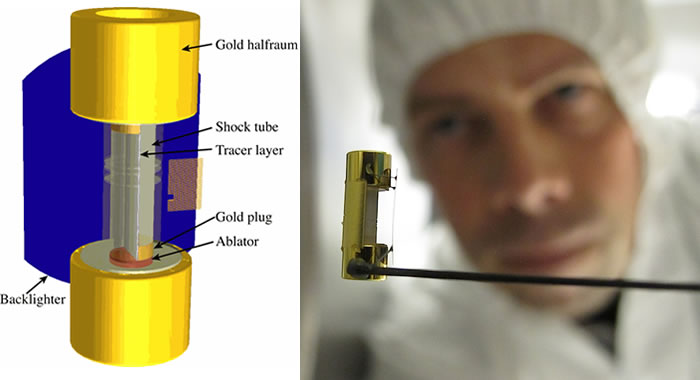Experimental Highlights - 2016
January
Laying the Groundwork for NIF Magnetized Targets
‘Shock/Shear’ Experiments Shed Light on Turbulent Mix
Scientists from Los Alamos National Laboratory (LANL) are leading an experimental campaign on NIF designed to further understanding of turbulent mix models used in both high energy density (HED) and inertial confinement fusion (ICF) experiments. NIF is the only facility with the energy and shot-to-shot reproducibility needed for the experiments.
During shots using what’s known as the “shock/shear” platform, NIF fires 300 kilojoules of laser energy at each end of a target comprised of two half-hohlraums to produce shock waves from opposite ends of a foam-filled shock tube. These waves turn the foam into plasma and allow the shocks to travel and create a counter-propagating shear mixing effect across a metal foil.
 (Left) rendering of a shock/shear target showing the two drive halfraums on each end of the grey shock tube in the center. (Right) Cryogenics operator John Cagle mounts a target on the NIF target positioner for an experiment. The area backlighter disc is seen edge-on on the right of the assembly. The front of the target is covered with a gold shield with a diagnostic slit.
(Left) rendering of a shock/shear target showing the two drive halfraums on each end of the grey shock tube in the center. (Right) Cryogenics operator John Cagle mounts a target on the NIF target positioner for an experiment. The area backlighter disc is seen edge-on on the right of the assembly. The front of the target is covered with a gold shield with a diagnostic slit. The target has evolved over time—different experiments have used titanium, copper, aluminum and roughened aluminum, and more materials are to come—but they all have one thing in common: each experiment enhances understanding of turbulent mix models in the HED regime. These models, developed and calibrated by LANL using hydrodynamic test data from the 1980s through the present, are now being examined through the lens of the shock/shear HED experiments to see how the data matches up to more extreme conditions.
“We have created a system that reproduces instability features similar to those of traditional hydro experiments that have not previously been seen in HED experiments,” said LANL scientist Kirk Flippo, the lead experimental investigator. “This kind of experiment is rapidly evolving our understanding and we’ve discovered a lot of behaviors that we didn’t expect.”
This enhanced understanding and refined data is vital for ICF. According to Flippo, it has become increasingly clear that ICF capsules experience some kind of mix as they are imploding.
“Some of the outstanding issues in ICF are how does the capsule mix, how does this play into the degradation of the yield and how does it affect ignition,” he said. “It’s important for us to make sure that when we run a code to model an ICF implosion, we get all of the details correct. These experiments will help us quantify precisely how much of an effect this type of shear mixing has.”
 In shock/shear experiments, counter-propagating shocks are launched across a 40-micron aluminum tracer layer with a velocity of about 155 kilometers per second. The graphic shows a calculated time-history of the evolution of the tracer layer from a preheat thickness of about 100 microns to a turbulent-driven mix width of 300 microns.
In shock/shear experiments, counter-propagating shocks are launched across a 40-micron aluminum tracer layer with a velocity of about 155 kilometers per second. The graphic shows a calculated time-history of the evolution of the tracer layer from a preheat thickness of about 100 microns to a turbulent-driven mix width of 300 microns. Shock/shear experiments initially were fielded on the OMEGA Laser at the University of Rochester’s Laboratory for Laser Energetics, but due to the limited volume that could be driven, the experiments were experiencing boundary effects. The LANL project manager, scientist John Kline, believed the platform was mature enough to be deployed on NIF and pushed hard for its implementation. Kline knew that by scaling the experiments up to NIF energies, the researchers would be able to take advantage of larger volumes to eliminate the edge effects and do the experiments they wanted to do.
“We cannot do experiments in this way anywhere but at NIF,” Flippo said. “In the regimes that we are in at NIF, the experiment behaves much more like a traditional hydro experiment and scales like a hydro experiment would scale.”
Data from the NIF experiments already has been used by the campaign’s principal investigator, LANL scientist Forrest Doss, to motivate refinements in the way the model is implemented in the code—producing a direct, immediate impact. But the work isn’t complete just yet.
“Now that this platform is available, and has been shown to produce really nice data, we can start modifying it by changing the shock velocities, changing the materials or foams and using different shocks,” Flippo said. “This platform has infinite variation and infinite complexity.”
Laying the Groundwork for NIF Magnetized Targets
LLNL researchers have taken the first steps toward determining if NIF inertial confinement fusion (ICF) and Discovery Science experiments might be enhanced by surrounding NIF targets with a powerful magnetic field.
The first experiment designed to lay the groundwork for a Magnetized Liner Inertial Fusion (MagLIF) campaign on NIF was conducted on Jan. 28 and produced “beautiful” data, researchers said.  The gas-pipe target with a shield and thin-wall radiography calibration plate.The room-temperature “gas-pipe” target experiment studied the propagation of a NIF quad (four beams) in a 10-millimeter-long epoxy pipe filled with one atmosphere of neo-pentane gas.
The gas-pipe target with a shield and thin-wall radiography calibration plate.The room-temperature “gas-pipe” target experiment studied the propagation of a NIF quad (four beams) in a 10-millimeter-long epoxy pipe filled with one atmosphere of neo-pentane gas.
The MagLIF campaign ultimately will use a magnetized target, a capability being considered for deployment on NIF in the next few years. The MagLIF concept was developed for the Z pulsed-power facility at Sandia National Laboratories and has been successfully tested on the Z machine and in ICF experiments on the OMEGA laser facility at the University of Rochester.
Preliminary calculations in a separate study suggest that externally imposed magnetic fields can help enhance the fusion burn rate in ICF ignition targets in two ways: by reducing heat conduction away from the assembled high-temperature plasma fuel, and by adding additional confinement to the charged particles produced by the fusion reactions, thus enhancing their localized energy deposition in the cold outer layers of fuel surrounding the central hot spot—a process known as alpha heating. The calculations show modest-to-large enhancements in plasma temperature and fusion-product deposition heating as a result of imposed axial magnetic fields.
Along with attempting to enhance ICF implosions, MagLIF experiments also could contribute to at least two Discovery Science campaigns: one studying radiation-hydrodynamic accretion processes in x-ray binary or cataclysmic variable (CV) stars, and another looking for plasma effects in a population of electron-positron (matter-antimatter) particles trapped in an externally created magnetic field (known as Pair trapping).
One proposed configuration for creating the magnetic field around the target would be to place magnetic-field-generating coils inside an air box in a NIF diagnostic instrument manipulator (DIM) or target/diagnostic manipulator (TANDM), which would then be inserted into the NIF Target Chamber. An alternative configuration would place the stored energy outside the Target Chamber and transport the pulsed power through a DIM or TANDM via coaxial cables. Laser-generated magnetic fields also are under discussion.
In the Jan. 28 NIF experiment, the NIF quad delivered 31 kilojoules of ultraviolet energy to the gas-pipe target in an eleven-nanosecond pulse at an intensity of 2×1014 watts per square centimeter. Beam propagation data was successfully obtained.



